Molti utenti di WordPress preferiscono lavorare sui propri siti web utilizzando un server locale sul proprio computer. In questo modo è possibile lavorare sul sito web in modo privato prima di rendere disponibili le modifiche on line.
Alla fine, dovrete spostarlo su un server live per renderlo accessibile ai visitatori online. Questa transizione è fondamentale per garantire il corretto funzionamento del sito web on line.
Abbiamo lavorato su molti siti web locali, quindi abbiamo dovuto imparare il modo più semplice per trasferire i contenuti a siti web in carne e ossa.
In questo articolo forniremo istruzioni passo passo su come spostare WordPress da un server locale a un sito live.
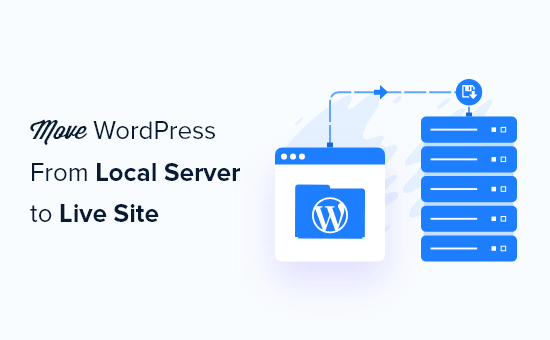
Perché spostare WordPress da un server locale a un sito live?
Creare il vostro blog WordPress su un server locale è un modo sicuro per testare le modifiche apportate al vostro sito web senza influenzare i visitatori.
Una volta perfezionato il sito web, il passo successivo consiste nel passare dal server locale a un sito live.
Vi mostriamo due modi per spostare il vostro sito da un server locale a un sito live.
Il primo metodo utilizza un plugin di migrazione di WordPress ed è consigliato ai principianti.
Nel secondo metodo, vi mostreremo come spostare manualmente WordPress da un server locale a un sito live.
Potete scegliere il metodo più adatto a voi:
Prima di migrare il sito WordPress
Per migrare WordPress da un server locale a un server live è necessario disporre di alcuni elementi.
Innanzitutto, supponiamo che abbiate un sito WordPress in esecuzione su un server locale (chiamato anche localhost) sul vostro computer e che abbiate pieno accesso ad esso.
Successivamente, è necessario disporre di un nome di dominio e di un hosting web.
Abbiamo sentito innumerevoli storie di principianti che hanno iniziato con fornitori di hosting web scadenti o gratuiti e se ne sono pentiti. Secondo la nostra esperienza, la scelta del giusto fornitore di hosting è fondamentale per il successo di qualsiasi sito web.
Per facilitare la vostra decisione, vi consigliamo di utilizzare Bluehost. Si tratta di una società di hosting WordPress ufficialmente raccomandata, che offre agli utenti di WPBeginner uno sconto esclusivo + dominio e SSL gratuiti.
In pratica, potete iniziare a lavorare con soli 1,99 dollari al mese.
Se volete un’ottima alternativa a Bluehost, potete dare un’occhiata a Hostinger. Offre anche uno sconto esclusivo agli utenti di WPBeginner con un nome di dominio gratuito.
Se potete permettervi di pagare un po’ di più, allora date un’occhiata a SiteGround. Hanno anche un’offerta speciale per i lettori di WPBeginner.
Se avete bisogno di aiuto per creare il vostro sito web, seguite la nostra guida passo passo su come creare un sito web.
Infine, è necessario disporre di un programma FTP e sapere come usare l’FTP per caricare il sito del server locale sul sito live.
Siete pronti? Iniziamo la migrazione del vostro sito WordPress.
Video tutorial
Se preferite le istruzioni scritte, continuate a leggere.
Metodo 1: Trasferire WordPress dal server locale al sito live utilizzando un plugin di migrazione (consigliato)
Questo metodo è più semplice e consigliato ai principianti. Utilizzeremo un plugin di migrazione di WordPress per spostare WordPress da localhost a un sito live.
Passo 1: Installare e configurare il plugin Duplicator
Per prima cosa, è necessario installare e attivare il plugin Duplicator sul sito locale. Per maggiori dettagli, consultate la nostra guida passo-passo su come installare un plugin di WordPress.
Suggerimento professionale: Esiste anche una versione pro di Duplicator che offre backup sicuri, archiviazione su cloud, ripristino semplice del sito e altro ancora.
Dopo l’attivazione, è necessario andare alla pagina Duplicator ” Backups e fare clic sul pulsante ‘Create New’.
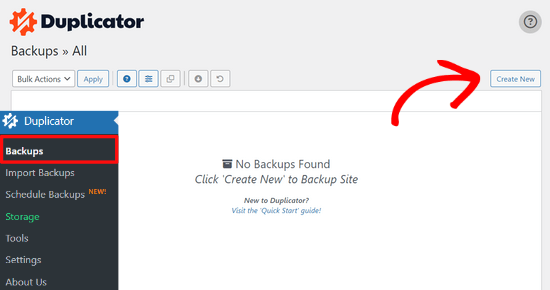
Si accede così a una schermata in cui è possibile assegnare un nome al backup.
Quindi, fare clic sul pulsante “Avanti”.

Duplicator eseguirà ora alcuni test per verificare che tutto sia in ordine.
Se tutti gli elementi sono contrassegnati da “Buono”, cliccate sul pulsante “Costruisci”.

Questo processo può richiedere alcuni minuti, a seconda delle dimensioni del sito web. È necessario lasciare aperta questa scheda fino al completamento.
Una volta terminato, verranno visualizzate le opzioni di download per i pacchetti “Installatore” e “Archivio”. È necessario fare clic sul pulsante “Scarica entrambi i file” per scaricare entrambi i file sul computer.

Il file “Archivio” è una copia completa del vostro sito WordPress. Include tutti i file principali di WordPress, nonché le immagini, i caricamenti, i temi, i plugin e un backup del database di WordPress.
Il file “Installer” è uno script che automatizza l’intero processo di migrazione scompattando il file di archivio contenente il vostro sito web.
Fase 2: Creare un database per il vostro sito web WordPress dal vivo
Prima di eseguire il programma di installazione o di caricare il sito web WordPress da localhost al vostro server di hosting, dovete creare un database MySQL per il vostro nuovo sito web live.
Se avete già creato un database MySQL, potete saltare questo passaggio.
Per creare un database, è necessario visitare la dashboard del cPanel del proprio account di hosting. Quindi, individuate la sezione “Database” e fate clic sull’icona “MySQL Database Wizard”.
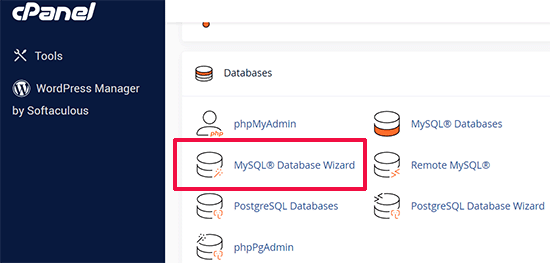
Nella schermata successiva, c’è un campo per creare un nuovo database.
È sufficiente indicare un nome per il database e fare clic sul pulsante “Crea database”.

cPanel creerà ora un nuovo database per voi.
A questo punto, è necessario inserire un nome utente e una password per il nuovo utente e fare clic sul pulsante “Crea utente”.
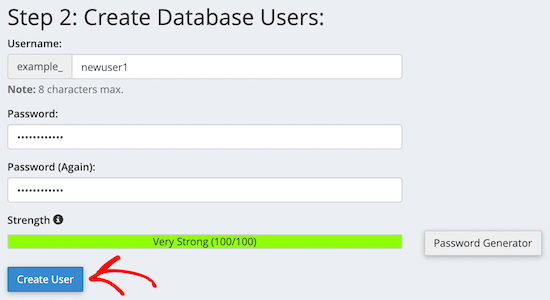
Successivamente, è necessario aggiungere l’utente appena creato al database.
Innanzitutto, fare clic sulla casella di controllo “Tutti i privilegi”.
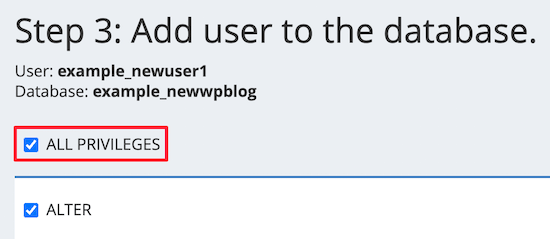
Quindi, scorrere verso il basso e fare clic sul pulsante “Applica modifiche” per salvare le modifiche.
Il database è ora pronto per essere utilizzato con il vostro sito WordPress. Assicuratevi di annotare il nome del database, il nome utente e la password. Queste informazioni vi serviranno nella fase successiva.
Fase 3: caricare i file dal server locale al sito web WordPress dal vivo
Ora è necessario caricare i file dell’archivio e del programma di installazione dal sito locale all’account di hosting.
Per prima cosa, collegatevi al vostro sito live utilizzando un client FTP. Una volta collegati, assicuratevi che la directory principale del vostro sito sia completamente vuota.
Normalmente, la directory principale è la cartella /home/public_html/.
Alcune società di hosting WordPress installano automaticamente WordPress al momento dell’iscrizione. Se sono presenti file di WordPress, è necessario eliminarli.
Successivamente, è possibile caricare i file archive.zip e installer.php da Duplicator nella cartella principale vuota.

Passo 4: esecuzione dello script di migrazione
Dopo aver caricato i file di migrazione, è necessario visitare il seguente URL nel browser:
http://example.com/installer.php
Non dimenticate di sostituire “example.com” con il vostro nome di dominio.
In questo modo si avvia la migrazione guidata di Duplicator.
Il programma di installazione eseguirà alcuni test e inizializzerà lo script.
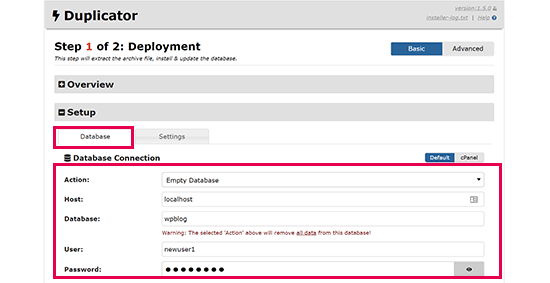
Nella sezione Setup, vi verrà chiesto di inserire l’host MySQL, il nome del database, il nome utente e la password.
L’host sarà probabilmente un host locale. Successivamente, si inseriranno i dettagli del database creato nel passo precedente.
Quindi, fare clic sul pulsante “Convalida” per verificare che i dati inseriti siano corretti.
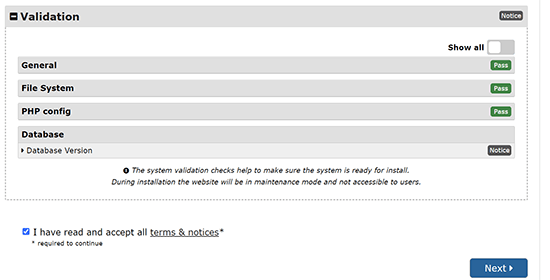
Dopodiché, fare clic sul pulsante “Avanti” per continuare.
Duplicator importerà ora il backup del database di WordPress dall’archivio al nuovo database.
Inoltre, aggiorna gli URL che puntano al sito locale e al nuovo sito live.
A questo punto è possibile fare clic sul pulsante “Admin Login” per accedere all’area di amministrazione di WordPress del sito live.

Una volta effettuato l’accesso al sito live, Duplicator pulirà automaticamente i file di installazione.
È tutto. Avete spostato con successo WordPress dal server locale al vostro sito live.
Metodo 2: Trasferire manualmente WordPress dal server locale al sito live
In questo metodo, vi mostreremo come spostare manualmente WordPress dal server locale al vostro sito live. Sarà utile se il primo metodo non funziona o se preferite farlo manualmente.
Passo 1: Esportare il database locale di WordPress
La prima cosa da fare è esportare il database locale di WordPress. Per farlo, utilizzeremo phpMyAdmin.
Se non lo conoscete, potete dare un’occhiata alla nostra guida alla gestione del database di WordPress con phpMyAdmin.
Basta andare su http://localhost/phpmyadmin/ e cliccare sul database di WordPress. Quindi, fare clic sul pulsante “Esporta” nella barra dei menu in alto.

Nell’opzione “Metodo di esportazione:” si può scegliere “Rapido” o “Personalizzato”. Personalizzato vi fornirà più opzioni per esportare il vostro database.
Tuttavia, si consiglia di scegliere “Rapido” e di fare clic sul pulsante “Vai” per scaricare il database.

Passo 2: caricare i file di WordPress sul sito live
Ora è necessario spostare tutti i file del sito web sul sito live.
Per iniziare, aprite il vostro client FTP e collegatevi al vostro account di hosting web.
Una volta collegati al sito live, assicuratevi di caricare i file nella directory giusta. Ad esempio, se si vuole che il sito sia ospitato su “yoursite.com”, si dovranno caricare tutti i file nella directory public_html.
Ora selezionate i file locali di WordPress e caricateli sul vostro server live.
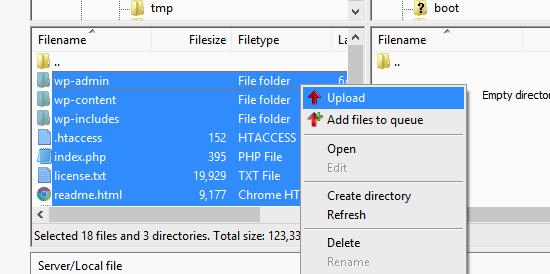
Passo 3: Creare un database MySQL sul sito live
Mentre il client FTP carica i file di WordPress, potete iniziare a importare il database sul server live.
La maggior parte dei fornitori di hosting WordPress offre cPanel per gestire il vostro account, quindi vi mostreremo come creare un database utilizzando cPanel.
Per prima cosa, è necessario accedere alla dashboard di cPanel e fare clic sull’icona “MySQL Database Wizard”, che si trova nella sezione “Database”.

Nella schermata successiva è possibile creare un nuovo database.
È necessario indicare un nome per il database, quindi fare clic su “Crea database”.

cPanel creerà automaticamente un nuovo database.
Successivamente, è necessario inserire un nome utente e una password per il nuovo utente e fare clic su “Crea utente”.
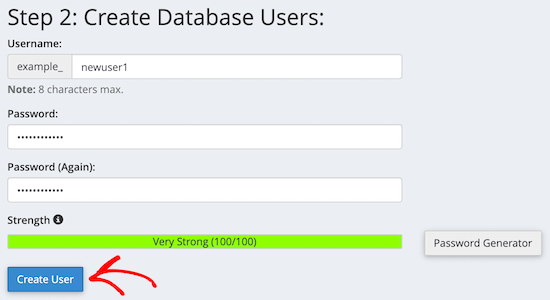
Successivamente, è necessario aggiungere l’utente appena creato al database.
Innanzitutto, selezionare la casella di controllo “Tutti i privilegi”.
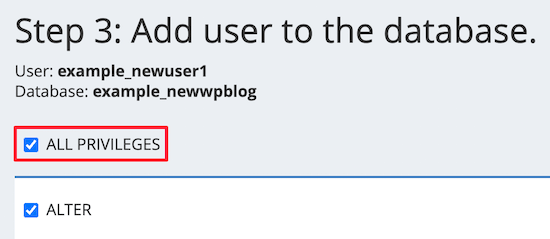
Quindi, scorrere verso il basso e fare clic su “Applica modifiche” per salvare le modifiche.
Avete creato con successo un nuovo database per il vostro sito WordPress live.
Passo 4: Importare il database di WordPress nel sito live
La fase successiva del processo consiste nell’importare il database di WordPress.
Andate nella vostra Bacheca cPanel, scorrete giù fino alla sezione “Database” e fate clic su “phpMyAdmin”.
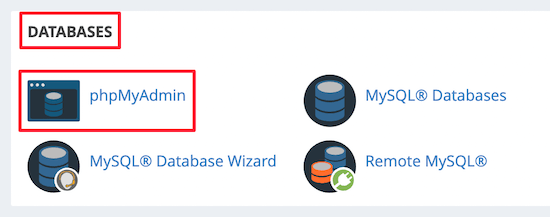
Si accede così a phpMyAdmin, dove si deve fare clic sul database appena creato. phpMyAdmin mostrerà il nuovo database senza tabelle.
Quindi, fare clic sulla scheda “Importa” nel menu superiore. Nella pagina di importazione, fare clic sul pulsante “Scegli file” e selezionare il file del database dal sito locale salvato nel primo passaggio.
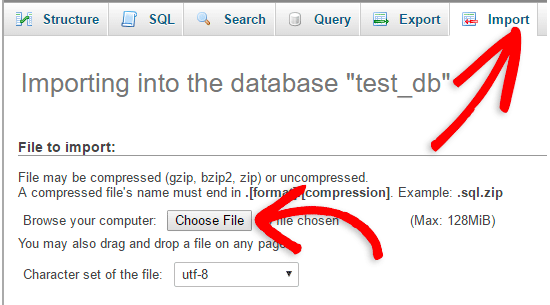
Dopodiché, fare clic sul pulsante “Vai” in fondo alla pagina. Il database verrà importato automaticamente in phpMyadmin.
Passo 5: modificare l’URL del sito
A questo punto, è necessario modificare l’URL del sito nel database in modo che si connetta con il sito WordPress attivo.
In phpMyAdmin, cercate la tabella wp_options nel database che avete appena importato.
Se si è cambiato il prefisso del database, invece di wp_options, potrebbe essere {nuovo_prefisso}_options.
Quindi, fare clic sul pulsante “Sfoglia” accanto a wp_options. Oppure, fate clic sul link nella barra laterale per aprire la pagina con l’elenco dei campi della tabella wp_options.
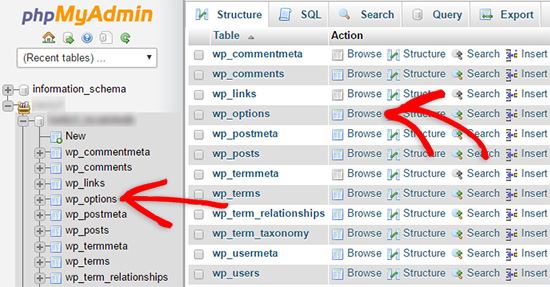
Quindi, nella colonna options_name, occorre cercare l’opzione siteurl.
Quindi, fare clic sull’icona “Modifica”.

Si apre una finestra in cui è possibile modificare il campo.
Nell’input boxed option_value, verrà visualizzato l’URL dell’installazione locale, che sarà qualcosa come http://localhost/test.
In questo campo è necessario inserire l’URL del nuovo sito, ad esempio: https://www.wpbeginner.com.
Quindi, è possibile salvare il campo facendo clic sul pulsante “Vai”.
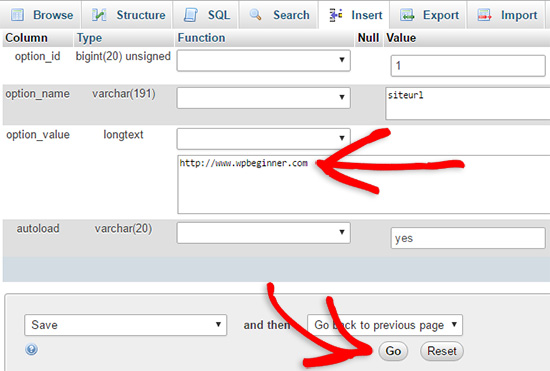
Successivamente, è necessario seguire la stessa procedura descritta sopra per il nome dell’opzione home. Il menu wp_options può essere lungo alcune pagine. Di solito, l’opzione home si trova nella seconda pagina.
Quindi, aggiornare l’URL della home, in modo che sia uguale a quello del sito live.
Passo 6: Configurare il sito live
Ora che avete importato il database e caricato i contenuti, è il momento di configurare WordPress.
A questo punto, il sito dovrebbe mostrare l’errore“Errore nello stabilire una connessione al database“.
Per risolvere il problema, collegarsi al sito web con un client FTP e aprire il file wp-config.php.
Dovrete cercare le seguenti righe di codice:
1 2 3 4 5 6 7 8 9 | // ** MySQL settings - You can get this info from your web host ** ///** The name of the database for WordPress */define( 'DB_NAME', 'database_name_here' );/** MySQL database username */define( 'DB_USER', 'username_here' );/** MySQL database password */define( 'DB_PASSWORD', 'password_here' );/** MySQL hostname */define( 'DB_HOST', 'localhost' ); |
È necessario fornire il nome del database, il nome utente e la password creati in precedenza.
Quindi, salvate il file wp-config.php e caricatelo sul vostro server di hosting WordPress.
Ora, quando si visita il sito web, questo dovrebbe essere attivo.
Dopodiché, è necessario accedere al pannello di amministrazione di WordPress e andare in Impostazioni ” Generale”. Quindi, senza modificare nulla, scorrere fino in fondo e fare clic sul pulsante “Salva modifiche”.
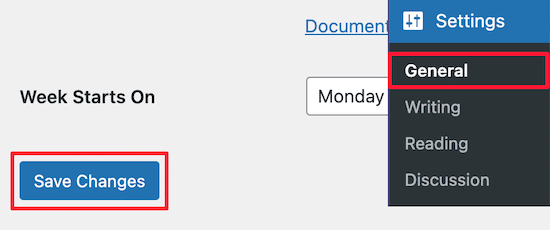
In questo modo ci si assicurerà che l’URL del sito sia corretto ovunque sia necessario.
Una volta fatto, andare su Impostazioni ” Permalinks, quindi scorrere verso il basso e fare clic su “Salva modifiche” per assicurarsi che tutti i link ai post funzionino correttamente.

Passo 7: Correggere le immagini e i link rotti aggiornando i percorsi
Ogni volta che spostate un sito WordPress da un dominio a un altro o da un server locale a un sito live, vi troverete di fronte a collegamenti interrotti e immagini mancanti.
Vi mostriamo due modi per aggiornare gli URL. Potete scegliere quello più adatto a voi.
1. Aggiornare gli URL con il plugin Search & Replace Everything (consigliato)
Il modo più sicuro per correggere questo problema è utilizzare Search & Replace Everything. Si tratta di un potente plugin per WordPress che consente di eseguire facilmente operazioni di aggiornamento di massa sul vostro sito web senza scrivere complesse query al database.
Per prima cosa, è necessario installare e attivare il plugin Search & Replace Everything.
Dopo l’attivazione, andare alla pagina Strumenti ” WP Search & Replace.
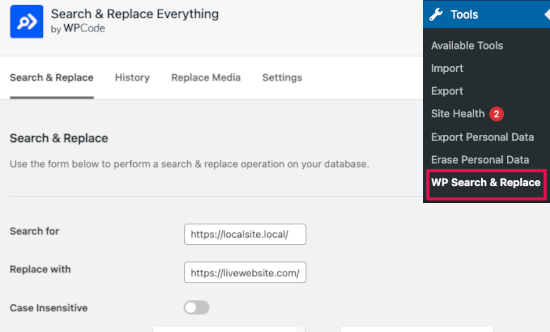
Da qui è necessario inserire l’URL del sito locale nel campo “Cerca” e l’URL del sito live nel campo “Sostituisci con”.
Scorrere un po’ e fare clic su “Seleziona tutto” sotto le tabelle. In questo modo il plugin cercherà il vecchio URL ovunque nel database.

Ora fate clic sul pulsante “Anteprima di ricerca e sostituzione” per continuare.
Il plugin cercherà nel database tutte le istanze del vecchio URL e vedrà l’anteprima dei risultati.
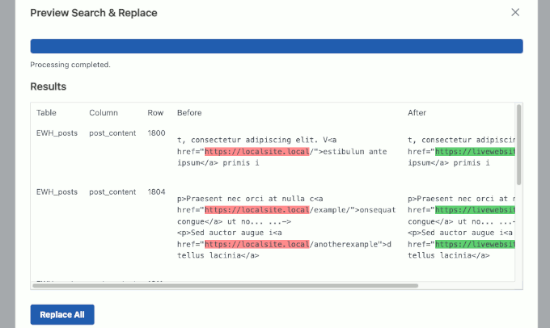
Se tutto sembra a posto, cliccate su “Sostituisci tutto” per salvare le modifiche.
Verrà visualizzata un’attenzione alle modifiche che si stanno apportando. Fare clic su “Sì” per continuare.
Il plugin aggiorna il database e sostituisce gli URL locali con l’URL attuale del sito web.
2. Aggiornare manualmente gli URL (avanzato)
Un altro modo per aggiornare gli URL è utilizzare la seguente query SQL:
1 | UPDATE wp_posts SET post_content = REPLACE(post_content, 'localhost/test/', 'www.yourlivesite.com/'); |
Basta andare su phpMyAdmin, fare clic sul database, quindi cliccare su “SQL” dal menu in alto e aggiungere la query di cui sopra.
Assicurarsi di modificare gli URL del sito locale e del sito live e fare clic sul pulsante “Vai”.
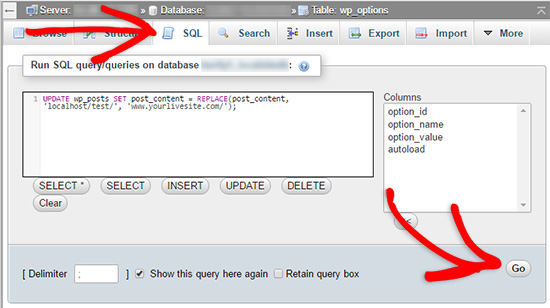
Ecco fatto. Ora avete migrato con successo WordPress dal vostro server locale a un sito live.
Speriamo che il vostro sito web sia attivo e funzionante senza problemi. Se notate degli errori, potete selezionare la nostra guida agli errori comuni di WordPress per aiutarvi nella risoluzione dei problemi.
Speriamo che questo articolo vi abbia aiutato a spostare WordPress da un server locale a un sito live. Potreste anche consultare la nostra guida sullo spostamento di un sito live su un server locale o dare un’occhiata alla lista di controllo definitiva per la migrazione di un sito web per i passaggi pratici della migrazione di WordPress.
Se questo articolo vi è piaciuto, iscrivetevi al nostro canale YouTube per le esercitazioni video su WordPress. Potete trovarci anche su Twitter e Facebook.





WPBeginner Staff
You can try deactivating all the plugins at once by renaming the /wp-content/plugins directory. Here is a tutorial.
Usually plugins store settings in WordPress database so hopefully most of your settings will not get affected by the change.
Neville Campher
I have moved my site from one domain to another, but my all my plugins are not working. If I re-install the plugins I will loose my settings, is there a way to keep my setting without loosing them
orangedrum
I’m wondering the same thing. Just uploading my files didn’t work and when I try and re-export the database I’m getting an error telling me these databases already exist. Help!
santhosh
thanks a lot it was easy and helpful for any beginner like me
Ajay Walia
Thanks wpbeginner.com. i got an Error Establishing Database Connection error (local host to server). then i found your post on google. now i solved this error.
David A. Bennett
Awesome tutorial! Just wondering, if I continued to develop on my website locally, could I simply re-upload the new files (‘m guessing the wp-content folder) via FTP to my site, or would I need to re-export the database everytime?
Naveen Mallikarjuna
After trying another method, I tried your method outlined above and it worked perfectly. Thanks much!
WPBeginner Staff
are you sure you have your site URL as your mysql host? it is usually localhost or a subdomain on your site like mysql.example.com. If you are unsure ask your hosting provider.
Chandara Tieng
Thank you WPBeginner, now every thing are working fine with your guide.
Chandara Tieng
“Error establishing a database connection” I am getting this problem and now not yet fixed.
here is my configuration in wp-config.php
<>
please help me define problem and fixed this.
Thank ahead for kindness.
ben
I quite appreciate your article but i have few problems. i have succesfully uploaded my site but the site is not recognising the style sheet and my admin page is blank after i logged in. what is the way out please?
Anjali
Thank you for this guide. You mention that a plugin such as Backup Buddy or Duplicator can be used to make the migration easier. I’m VERY new to using WordPress, so the answer to this question may be painfully obvious. Would you install the plugin to the local site or the live site before the migration?
Wasim
After completing all the above steps , do in need to replace my index.html file
WPBeginner Staff
No, you don’t.
Roland
First off: thanks a lot for your great blog – it gave me the idea to try WAMP to develop my three current WP site projects!!
I did not install WP on localhost yet, because i am wondering if there could be a problem when I use a multisite installation during the move to the live server of my client.
I would like to develop the 3 sites for my client in one single database through the WP multisite feature. However i am unsure if everything will be fine when going live because I intend to use an alternative multisite installation method by mapping the three distinct domains onto one SQL database (via this plugin: http://wordpress.org/plugins/wordpress-mu-domain-mapping/). I.e. I want to develop example1.com + example2.com + example3.com on my localhost in a multisite setup and export the sites later onto the production server.
If someone could clear my doubts as to whether this could be a potential source for problems later on, please do so.
In that case i would develop 3 separate instances of wordpress, although i would like to avoid this at all costs.
Thank you! Roland
dpi
It works fine. Awesome guide. Thanks WPB
Jørgen Wolf
I loved this. Very good guide. Thank you very much, my site is now online!
Ramo
Thank you very much
WPBeginner Staff
The most probably cause is that your new database is empty, WordPress successfully connects to your new database. Then it finds out that the database is empty and assumes that its a new site. What you need to do is to import your old database. After that you will need to change your sitename and site url and update your links. See this guide.
John Kiathe
That was a nice guide. Thank you.
Crocker27
Hi,
Great tutorials thanks very much! I’ve created my own theme from scratch and am just in the final stages of putting it online, but I have hit a snag…
What could cause the 5 minute install page to come up when I direct my page to the new sql database?
I have exported the SQL database from my localhost. Created a new database on the server and imported it there and I changed the wp-config file to direct to the new database. When I did that I was directed to the 5 minute install page.
When I leave it on the old database, my theme works (although the content/posts/menus etc are all wrong) so I don’t understand what I’ve done. I am guessing it’s something wrong with the database but I have no idea what!
Thanks for your help!
Paul Seidel
I’ve uploaded my website multiple times to the FTP, changed the wp-config, the SQL databases, etc – but for some reason “wordpress” is still in the address ( , etc.) and I can’t log into the backend. Help !
Christopher
i have the same problem
WPBeginner Staff
Those changes will be lost if you uploaded an older version of the database from your local server.
Andrew Avantgardian
Worked like a charm, except i didn’t even need the last step (the MySQL query) for some reason all my links and pictures were fine after the transfer, perhaps it has something to do with the new version of WordPress.
Anyways thanks for this guide
Naveed
Thanks a lot for the tutorial. I was mislead by some plugins claiming automatic transfer.
Excellent work. Keep it up.
WPBeginner Staff
This article assumes that your live site is actually developed on localhost, so it does not assume that you have already taken down a live site to to work on it.
In case you are working on a live site by creating a local copy on your computer. Then this strategy is usually used to only work on site’s layout, adding new features, or testing some functionality. This way you can work on your website without modifying any data and when you move the site from localserver to livesite your database usually remains unchanged.
Hope this helps
npp07
Thanks, but do you have any articles to recommend on how (if possible) to make changes to a website with a community contribution aspect (comments, forums, etc) and be able to develop to include creating posts (not just used for a blog, but something like BuddyPress or Symposium) without overwriting comments added between development versions?
Guest
Yse Livefyre and Disquss comment system
npp07
I thought I replied, but I don’t see it here… by adding new features, do you mean like adding pages and posts using BuddyPress? If a conversation keeps going on the live site while I am developing, will those conversations be lost or merged when I upload to the live site?
npp07
Thanks for the great article, I have done this with a static site before, but in the article you say this is how WPBeginner.com does it daily (but with BackUpBuddy). I haven’t used BackUpBuddy yet, but plan to for a new project.
My question is how does this work for a site with the community commenting? Wouldn’t you lose the comments already on the database if you repeat this process daily and overwrite a database? Is there a slightly different step involved for building development updates onto an already live site?
Husnain
All works fine .. but my header image not work (Crash) .. and when i save permalink in setting it says Connection not established !!
Jenna
Hello!
When I try to import gripped database I get:
SQL query:
—
— Database: `wpdb`
—
— ——————————————————–
—
— Table structure for table `wp_commentmeta`
—
CREATE TABLE `wp_commentmeta` (
`meta_id` BIGINT( 20 ) UNSIGNED NOT NULL AUTO_INCREMENT ,
`comment_id` BIGINT( 20 ) UNSIGNED NOT NULL DEFAULT ‘0’,
`meta_key` VARCHAR( 255 ) DEFAULT NULL ,
`meta_value` LONGTEXT,
PRIMARY KEY ( `meta_id` ) ,
KEY `comment_id` ( `comment_id` ) ,
KEY `meta_key` ( `meta_key` )
) ENGINE = INNODB DEFAULT CHARSET = utf8 AUTO_INCREMENT =1;
MySQL said:
#1046 – No database selected
—
How can I fix this?
Thanks,
Jenna
landi
clean and simple
Changa Masomakali
This is a great article!! Thanks so much for it. But I am not able to pull my site up. I think it has something to do with with the DB Hostname in the wp-config file. What should this be?
Bloodico
This is absolutely a great article !! THANK YOU !!
It would be perfect if you mentioned to also check the wp_postmeta when replacing ‘localhost/test/’ by ‘www.yourlivesite.com/’ on step 7
and added a Step 8 for the.htaccess file which have to be modified too (if it isn’t done automatically ?)
the line “RewriteBase /test/” has to be suppressed and the line “RewriteRule . /test/index.php [L]” has to be changed to “RewriteRule . /index.php [L”
Once again a BIG thank you for this great article that made my day so easy !!
B-Designs
This was exactly the fix I needed for my clients site.
Thank you so much for your insight
David
Im having issues logging in to my admin panel. Site displays correctly but links dont work even after executing the sql script. When I try to log in, no error is returned, the form just clears. Any ideas?
Miguel Leite
Hey there.
Wonderful post!! Thanks a lot, helped me doing this for my very first time, correctly.
I’d like to ask: to do the reverse: moving wordpress from live site to local site, I just have to do de process starting with the live server and ending in the local?
Transient
thanx a lot
Hardeep Kaur
Thank you very much !!! really helpful.
nickesh
i complete all the steps but wp-admin page cannot be accessed and it shows following error
Warning: Cannot modify header information – headers already sent by (output started at /home/sulakasa/public_html/sulakasa/wp-content/themes/CherryFramework/includes/less-compile.php:155) in/home/sulakasa/public_html/sulakasa/wp-includes/pluggable.php on line 1121
Marisa Di Monda
This might be too late but if you or anyone has this problem again this helped me:
https://wordpress.org/support/topic/wp-admin-has-a-redirect-loop-after-migrating-to-new-server
WPBeginner Staff
WordPress.com is still managing your domain name. You can transfer your domain’s registration to your new webhost. Or you can simply update nameserver information for your domain on WordPress.com and point it to your new webhost. Please see the instructions in our guide on how to properly move your WordPress.com blog to WordPress.org
WPBeginner Staff
Yes you could just simply install WordPress and then upload your theme.
jellman
I’m confused, is this to also migrate posts? I have a wordpress site developed locally but with zero content yet. therefore can’t I just install wordpress on my dreamhost site, then move the theme files on my computer to the live server?
WPBeginner Staff
You can not edit theme or install plugins on WordPress.com. Please see our guide on the difference between WordPress.com vs WordPress.org
Mawuli
I have already exported my wordpress.com site to wordpress.org during the installation as your tutorial guided me.
But my problem is, I already have a domain with wordpress.com and when i was trying to move my site to live, i received those feedbacks….May i know if wordpress.com is still my host or i need to purchase another hosting account?
Mawuli
I have a domain with wordpress.com. After successfully installing wordpress with wampserver through your tutorial, I managed to design a new website, uploaded and used all the necessary plugins.
Now, the next thing I want to do is to move to a live site and that’s why I arrived here to be able to display my new site but am stucked in the first step.
I am using File Zilla as my FTP client. I was asked to enter my host name which I did with the name (wordpress.com). I entered my username, password and port number (21). But this is what I get when I try to connect
“Error: Connection timed out
Error: Could not connect to server”
What shall I do? Do I need to buy a hosting service or wordpress.com is still my host. I don’t seem to get this hosting thing at all. Explain this to me.
Thanks you
WPBeginner Staff
Installing WordPress using Sofaculous is not a requirement,
MHK
All the steps in this work as expected….WONDERFUL!!!!, however it should be include in this tutorial as Step One or Prerequisite………That we need to install wordpress from Softaculous and then delete the database created by it and import the database into it and after installing wordpress from softaculous should import the WP files from FTP.
I am facing a strange error. Chrome is opening my website as expected……IE keeps showing the Under construction page?? Any thoughts will be highly appreciated…….I have deleted the index.html file
Yazz Am
Hello, I get ‘Error establishing a database connection’ at step 6 when I try to login to my wordpress admin panel. Help please.
Ferdinand
I want to set up a site on local host which I want to manage locally. I would write the articles and upload them to webhost after I write them. Do I need to update the site and php database in the way that you mentioned above every single time I write a post? Or is there any way to upload only the files that got changed? This I want to know since it would be very time saving to manage the site offline for me.
Rizky M R
My site has working, but i can’t open any page and post of my website, and also the image still doesn’t show up after the sql query fix
Charlie Barnett
Hi, I have found your explanation extremely useful and have managed to trasnfer my locally hosted wp site live. However when I try step 6 to login I can’t seem to login and it throws the following error:
Internal Server Error
The server encountered an internal error or misconfiguration and was unable to complete your request.
Please contact the server administrator, and inform them of the time the error occurred, and anything you might have done that may have caused the error.
More information about this error may be available in the server error log.
Additionally, a 500 Internal Server Error error was encountered while trying to use an ErrorDocument to handle the request.
Does this make sense have I missed something in my upload?
Thanks Charlie
WPBeginner Support
Please take a look at how to fix the internal server error in WordPress. Due to generic nature of this error, it usually does not tell you where to look for the problem.
Admin
wanda serros
My site is up but it’s still not completely functional. When I click on some of my images to get an enlarged view I get a message saying ‘The requested content cannot be loaded. Please try again later.’
I’ve looked in my database and I see that there are still instances of ‘localhost’…. in some fields. I did run the Update to ‘post_contents’ query already. Should I run additional queries to change every mention of ‘localhost’ in the database to my website address?
Thank you. Your site has been very helpful.
Timothy
Ofcourse, replace every instance of localhost and localhost/
Lisa
I figured out how to upload the database, finally. made those text editor changes within the sql file first. Now I’ve done all of the other steps, including changing the wp_options “home” and “siteurl” … and also editing the wp_config.php file from within my live c panel file manager and making those updates. I still get an “error establishing database connection”. I did notice when I installed wordpress on my new hosted site, it created its own database (ss_1). Should i delete that one?
WPBeginner Support
The most common reason for the error is usually incorrect password, database, username or host information. It has nothing to do with other databases on your mysql server, so there is no need to delete them. Make sure you are entering correct information for your database in your wp-config.php file.
Admin
Karlo
I followed your instructions to make a local copy of my live website (the other way around).
The only problem I’m experiencing is that the stylesheet isn’t loading and that my images arent showing up, not even on WP backend.
Do I need to run another SQL query to fix this?